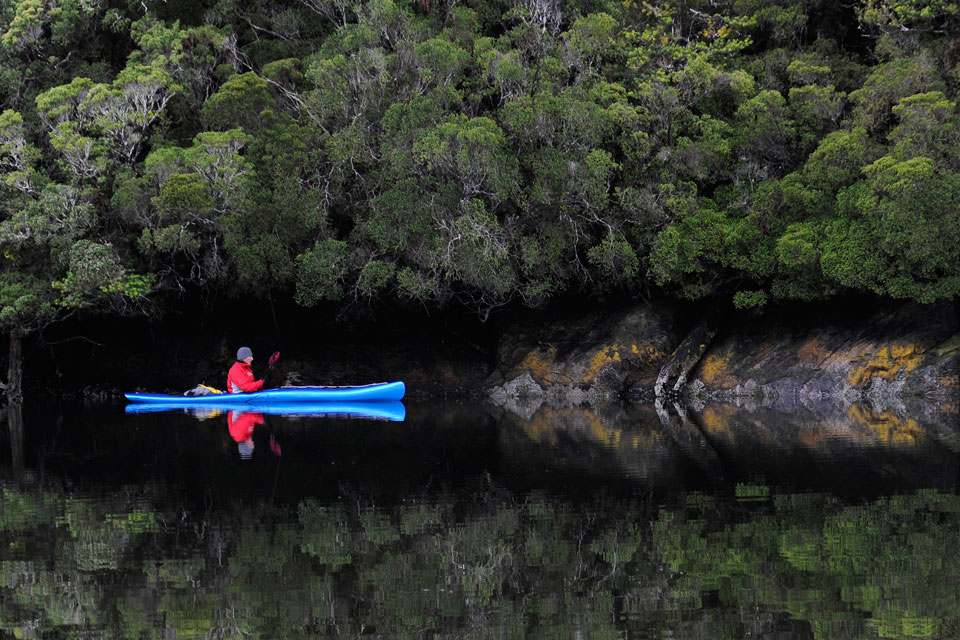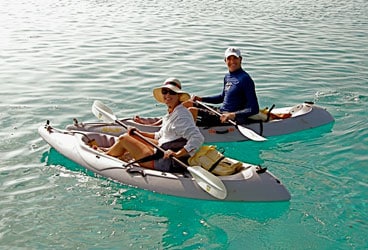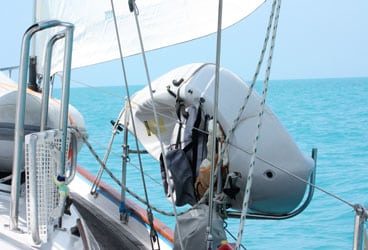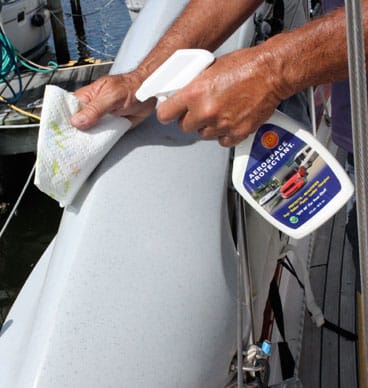
Kayak
Kayaking is one of America’s fastest growing sports, and judging from the increasing number of kayaks aboard cruising boats, more and more sailors are discovering the joys of a paddle in paradise. Once you start sailing with kayaks, you’ll discover that there’s nothing quite like effortlessly gliding through crystal-clear water while silently exploring places you could never reach in a dinghy. Dolphins splash, sea turtles slip past, and flying fish provide endless entertainment as the kayak drifts by. Beaching your kayak on an uninhabited sandy beach with wavelets lapping the shoreline is pure magic and really enhances the cruising experience.
Kayaks provide different things for different people. For me, it’s the peace I feel dipping my paddle in the water and anticipating new adventures around the next bend. Others love the exhilaration of surfing down waves; still others use their kayaks as platforms for fishing and diving.
Whatever the rationale, from the inquiries we get from fellow cruisers asking to buy our kayaks, others clearly wish they’d brought these functional boats along with them. If you’re considering sailing with kayaks, here are a few tips.
In style and materials, the choice is yours: decked or sit-on-top models; inflatable or folding ones; boats made of plastic, fiberglass, or even carbon fiber. When we began shopping for our kayaks, we at first considered inflatable models. When we tested them, however, though we acknowledged that they’d stow better, in our opinion they just didn’t paddle well. Since then, several companies have introduced inflatable kayaks made of Hypalon; they’re very rigid and comfortable, with inflatable keels and even rudders, making them a much more attractive option on a cruising boat, where space is at a premium.
Materials aside, different kayaks are suited for different activities. If you’re serious about surfing or fishing, for instance, consider a kayak specially made for those activities. If you’re like me and just want a good all-around kayak, a more generic version will be fine. Your best resource will be a high-quality kayak store that carries multiple types and brands. There you’ll be able to explore the differences in boats and styles and decide what is best for you.
Kayak Considerations

Length, width, and hull shape affect speed, maneuverability, and stability. Short, wide kayaks are more stable and easier to board from a moving boat. But a shorter kayak won’t track as straight as a longer, narrower version. Long, thin kayaks slice through the water quicker and easier but are more difficult to turn. Short, beamy kayaks promote stability and turn easier but require a bit more effort to maintain momentum.
Most recreational plastic kayaks aren’t equipped with rudders, which can be useful in strong current and wind, allowing you to paddle evenly while your foot pedals control the rudder to adjust your course. We don’t have rudders on our 9-foot Wilderness Systems Riot kayaks, and we haven’t missed them.
Plastic kayaks, the most durable, are also the heaviest. (That said, don’t be overly concerned with weight; our 9-footers weigh about 40 pounds but are easily hoisted aboard.) They’re also the least expensive, so you won’t feel as guilty if they get scratched or dinged. Fiberglass, inflatable, or carbon-fiber kayaks are more susceptible to nicks when dragged over rocky shorelines, but if you’re spending lots of time paddling, their lightness will be much appreciated.
In our opinion, sit-on-top kayaks have a few advantages over sit-in kayaks, especially for cruisers. The former have open decks and, because they’re easier to board and use and less confining, many paddlers feel they’re more comfortable. There’s also no risk of being stuck inside if the kayak tips. Beginning paddlers especially enjoy sit-on-top models, which are even cozier with an optional seat. Of course, decked kayaks are drier, especially if you wear a cockpit spray skirt when paddling.
Some cruisers enjoy tandem, two-person boats, which are fun for couples to paddle. The downside is that such kayaks don’t perform well with just one person on board. And while there are a dizzying array of paddles and accessories available, only two are necessities. The first, of course, is the paddle. Ours break down into two pieces for easier storage. Make sure you get the right size: Beamy kayaks require paddles that are long enough to clear the sides, as there’s nothing more annoying than banging the edges with every stroke. A rule of thumb when assessing a paddle is to hold it on top of your head. Bend your elbows 90 degrees and grasp the paddle on both ends overhead. Ideally, there should be a 4- to 6-inch gap between your hands and the blade. Because our kayaks are beamy, I actually have a 6- to 7-inch gap. A good kayak store can assist you with sizing.
For us, the other critical accessory is a comfortable seat, and we recommend purchasing the best that you can afford. Try a few different ones to decide which is right for you.
When purchasing a kayak test several different models. Some stores have demo models for this purpose. We tested four different types—a pair of sit-ins, a sit-on-top model, and an inflatable—before we made our decision. If you can’t find a store that provides “test rides,” ask if you can rent the type of boat that you’re considering beforehand. Or take a kayak excursion trip with a company that has kayaks similar to what you’re interested in purchasing.
Storing Kayaks

Unfortunately, kayaks are out of the water more than in, so you need to think about launching and retrieving and onboard storage. When it comes to stowage, there are several options. We carry our two aforementioned 9-footers on Winterlude, our Passport 37. They nestle nicely in stainless-steel cradles affixed to the forward lifeline stanchions; the “swinging” cradles allow mounting inside or outside the lifelines. When at anchor in a blow, to reduce windage we take the boats out of the cradles and lash them to the handrails on the cabin top.
Because our side decks are narrow and we carry our dinghy on the foredeck, when under way, we usually stow the kayaks outside the lifelines. Yes, we realize that they could be swept off by a wicked wave, but after 10 years and almost 10,000 nautical miles, it hasn’t happened yet. Other sailors lash their kayaks to the cabin top, secure them above the bimini hardtop, or even make them fast to their dinghy davits. It really depends on the characteristics and layout of your particular boat.
Whichever way you go, you won’t regret bringing along kayaks on your cruise. From exercise to exploring, they can’t be beat.
Kayak Safety
Paddle with a buddy boat whenever possible. If there’s no one available and you want to paddle, make sure someone knows where you’re going and when you expect to be back. Carry along a handheld waterproof VHF radio.
Practice getting in and out of your kayak. Try different entry points from your boat until you discover the one that’s easiest for you. We used to slide into the kayaks from our dinghy until we discovered it’s almost as easy to step down from our wide rubrail directly into the kayak when it’s secured to the boat on a long painter. I steady it for a moment, then lower myself into place. I leave the paddle on the deck of our boat but within reach until I’m lowered in and can grab it.
Once aboard, sit quietly in the kayak and let the current or wind take you to determine if there are significant amounts of one or the other and which way it’s pushing you. Always paddle upcurrent or upwind first as a test to determine how difficult it might be to get back. Last winter, in the Little Shark River in Everglades National Park, the current was fierce, but I really wanted to go for a late-afternoon paddle. I tested conditions three different times until I felt comfortable that I could get back upcurrent to the boat.
Wear or have a life jacket within easy reach in case you need it. If you’re new to paddling, you should probably always wear your life jacket until you gain confidence getting in and out of the boat.
Before it actually happens, practice falling out of the boat. Paddle to a calm beach and deliberately capsize. See if you can get back in. Then do it again in water just over your head. I can get back in my kayak from deep water by placing the paddle at a 90-degree angle to the kayak and using it to help pull myself in. Depending on your boat and on your skill levels, everyone will have a different technique, so learn yours.
Always take water shoes or flip-flops: You never know when you might want to hop out and pull the kayak ashore for a look around, perhaps on a rough shoreline. We actually think Crocs are ideal; they float, aren’t smelly, and don’t cost an arm and a leg should we lose one overboard.
Kayak Care

Looking for “sunscreen” for your kayak? Try a product called 303 Aerospace Protectant. We reapply it at least every six months and sometimes in between. Canvas covers also work well, but we’ve had good results with the less expensive 303. As with all cruising equipment, a good freshwater rinse from time to time is beneficial.
Always store seats, life jackets, paddles, and extra stuff inside the boat when not in use for extended periods. Having said that, we do leave our seats and life jackets on the kayaks while we’re cruising six months a year because it’s easy not to use them if it’s too much trouble to get them ready.
Handles and webbing won’t last forever in the tropical sun, so be sure to have replacements; we’ve replaced ours twice in six years. The 303 Protectant will slow but not stop the deterioration.
With her husband, David, Jan Irons spends half her time stateside and the other half cruising in distant locales aboard the couple’s Passport 37, Winterlude; visit her website (http://www.commutercruiser.com) to read of their adventures. Jan is also the co-author, with Carolyn Shearlock, of the recently published The Boat Galley Cookbook (International Marine).








